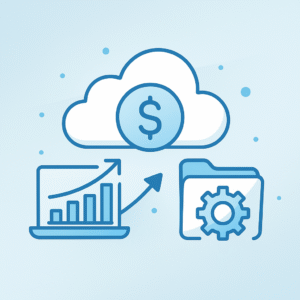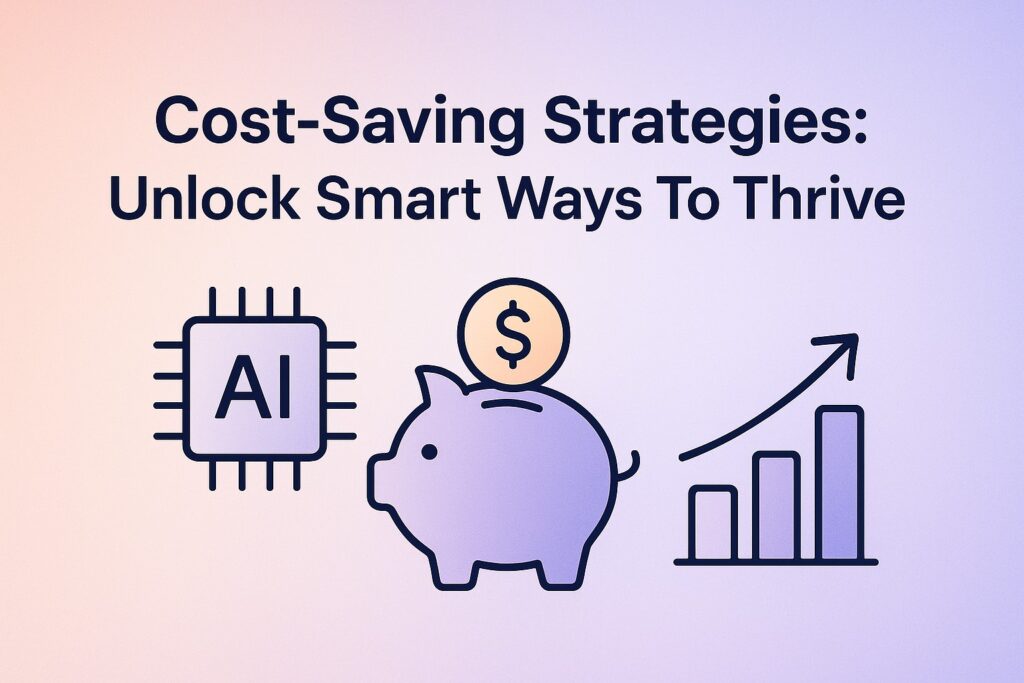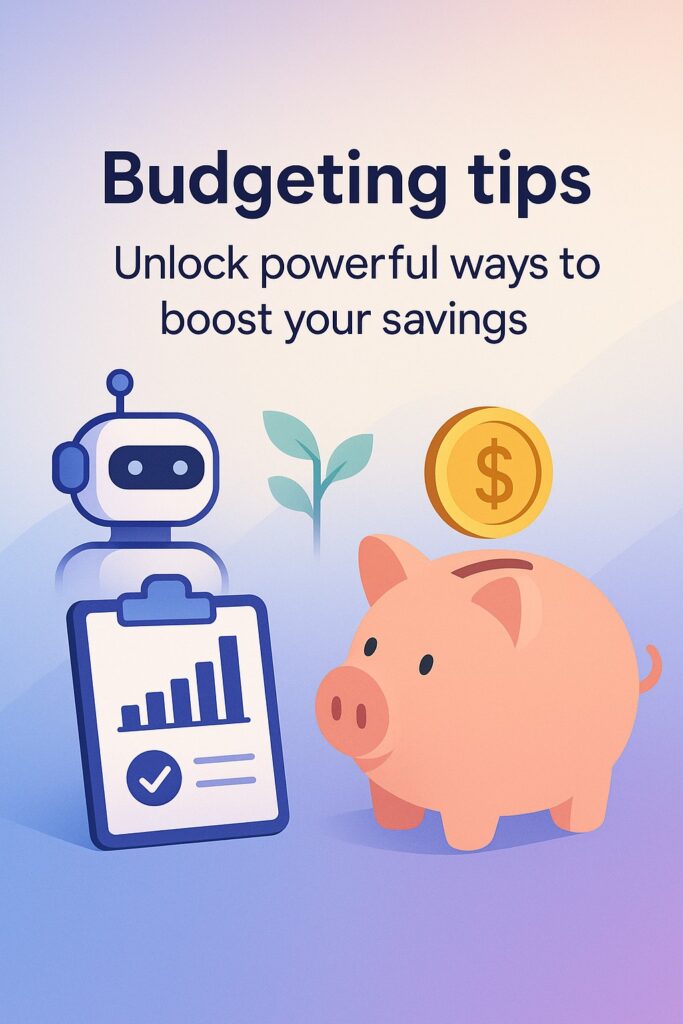Tired of running out of cash too soon? These easy cost-saving strategies will help you spend smarter, save more, and still enjoy the things you love.
Saving money isn’t always easy—especially when you’re dealing with school, part-time jobs, or just trying to enjoy life on a budget. That’s where cost-saving strategies come in.
These strategies are smart, simple ways to help you spend less and keep more of your money. Whether it’s finding better deals, using budgeting apps, or changing small habits, cost-saving strategies can make a big difference. You don’t need to be an expert to use them—you just need to start.
For students and young adults, learning how to manage money early is a game-changer. The good news? Most cost-saving strategies are easy to follow and work with your daily routine. This blog will show you how to make your money go further—without giving up the things you enjoy.
Table of contents
- Cost-saving strategies using AI-powered reduction tools
- Best automation tools for cost-saving strategies
- How do cost-saving strategies use predictive analytics?
- Cost-saving strategies with AI tools for budgeting
- Cloud cost-saving strategies for startups that scale
- How AI improves financial planning and cost savings?
- Tech-driven budgeting tips for smart cost-saving strategies
- Cost-saving strategies through business automation
- Smart budgeting tools that boost cost-saving strategies
- Data-driven cost-saving strategies made simple
- FAQs: Cost-saving strategies
- Conclusion
Cost-saving strategies using AI-powered reduction tools
Smart tech to help you spend less and save more. AI isn’t just for robots or coding. It’s now a smart way to cut daily and business costs. These AI-powered tools can help you track spending, reduce waste, and make smarter choices with your money. Whether you’re managing a side hustle or just trying to stretch your allowance, cost-saving strategies backed by AI can make a real difference.
Automate to avoid overspending
AI tools can learn your spending habits. Apps like Cleo or Emma use smart budgeting and alerts to show where your money goes. They suggest ways to save instantly—like canceling unused subscriptions or switching to cheaper services. These tools do the thinking for you, so you don’t slip into bad spending habits. That’s one of the simplest cost-saving strategies to start using today.
Use AI to analyze and cut hidden costs
AI also helps you find hidden expenses. For example, if you’re using cloud storage or apps with monthly plans, tools like YNAB or Truebill review your bills and flag what’s wasting your cash. These apps highlight areas where small savings add up. This makes your cost-saving strategies more detailed and personalized.
Smarter planning with predictive tools
AI doesn’t just look at what you’ve done—it can predict what’s coming. Tools like ChatGPT or Notion AI help you plan better. Let’s say you’re budgeting for a trip or a group project. These tools suggest cheaper options based on current prices and trends. That means fewer last-minute surprises and more control.
In short, AI-powered reduction tools make cost-saving strategies easier, smarter, and quicker. And with so many free or cheap options, there’s no reason not to start saving today.
Best automation tools for cost-saving strategies
Save time, money, and effort with smart tools. Automation sounds complex, but it’s actually simple—and super helpful. With the right tools, you can stop wasting time on small tasks and start saving money without even thinking about it. These tools are perfect for students juggling studies, part-time jobs, or small side hustles. Let’s explore how automation fits into smart cost-saving strategies.
Schedule and save with automatic payments
Apps like Mint and Goodbudget let you set up bill reminders or auto-pay features. This helps avoid late fees or overdraft charges. You can also link them to bank accounts and get updates when your spending gets too high. It’s a great way to keep track and stick to your cost-saving strategies without checking everything manually.
Use smart shopping extensions
Browser tools like Honey or Capital One Shopping find the best deals while you browse online. They automatically apply coupons and compare prices. This saves money every time you shop—without extra effort. These automation tools fit perfectly into your cost-saving strategies, especially during sales or when buying tech or study supplies.
Automate savings and budget tracking
Apps like Qapital or Digit move small amounts of money into your savings based on your habits. You can set rules like “save $5 every time I eat out” or “round up spare change.” It happens in the background, so you save without noticing. These smart tools turn your daily choices into real results.
Using automation tools helps you apply cost-saving strategies without stress. The best part? You don’t have to remember everything—tech does the hard part for you. Try one or two of these and see how quickly you can save.
How do cost-saving strategies use predictive analytics?

See your future spending—and fix it before it happens. Predictive analytics might sound like something out of a sci-fi movie, but it’s a real tool used in everyday money-saving apps. It works by using data from your past spending to guess what you might spend in the future. This helps you make smarter choices now. When it comes to smart cost-saving strategies, predictive analytics gives you a huge advantage.
Spot patterns in your spending
Apps like Cleo or PocketGuard study your past purchases. They look for patterns, like when you usually overspend or forget to budget. Based on that, they alert you before it happens again. This helps you avoid waste and plan better. These insights turn your cost-saving strategies into more personal, smart, and proactive plans.
Make smarter plans with forecasts
Predictive analytics doesn’t just tell you what you did—it shows what could happen next. For example, if you always spend more during exam weeks on takeout, your app might remind you early to plan meals or set limits. That’s real power. It’s like having a personal money coach helping you stay ahead. Adding this tech to your cost-saving strategies gives you a clearer view of what’s coming.
Avoid financial surprises
Unexpected bills are the worst. But with predictive tools, you can prepare for them. Apps like YNAB (You Need A Budget) or Emma use trends to warn you about future expenses. They help you set aside money for rent hikes, yearly renewals, or even holiday spending. So instead of scrambling later, you’re ready.
In short, predictive analytics helps your cost-saving strategies go from basic to brilliant. It’s like knowing tomorrow’s weather—you get to pack your umbrella before the storm hits.
Cost-saving strategies with AI tools for budgeting
Make smarter money moves with the help of AI. Budgeting doesn’t have to be boring or confusing. Thanks to AI tools, it’s now faster, easier, and more accurate. These tools track your income, spending, and habits—all while giving you helpful tips. That’s why many students now use AI for better cost-saving strategies.
Create instant budgets based on real data
AI tools like Monarch and Wally analyze your bank activity and set up a budget for you in seconds. No need to guess how much to spend or save. These apps use your real numbers to create limits for food, transport, shopping, and more. It’s an easy way to stay on track with your cost-saving strategies without doing any math.
Get personalized tips and alerts
Some budgeting tools, like Cleo or Buddy, send you smart tips based on your habits. If you always overspend on weekends, they’ll remind you before Friday hits. That’s what makes them special—they don’t just track; they guide. These nudges help you build better habits as part of your cost-saving strategies.
Save while you spend
Many AI apps now offer “round-up” features. Every time you buy something, the app rounds the purchase up and saves the extra cents. It may sound small, but it adds up fast. You save without even noticing—and that’s a win.
Using AI for budgeting means you don’t need to be an expert. These tools help you manage your money with less stress and more success. It’s one of the smartest cost-saving strategies you can start right now.
Cloud cost-saving strategies for startups that scale

Smart ways to save on storage, servers, and software. Running a startup in the cloud is cool—until the bills hit hard. Hosting, storage, and tools can get expensive fast if you’re not careful. That’s where smart cost-saving strategies come in. With the right moves, you can save money and still grow fast.
Choose the right pricing model
Many cloud platforms like AWS, Google Cloud, or Azure offer different pricing plans. Some are pay-as-you-go, while others give discounts for long-term use. If you’re just testing ideas, go with free tiers or trial credits. Once you scale, switch to reserved plans to cut monthly costs. This simple switch supports long-term cost-saving strategies without slowing you down.
Auto-scale your resources
Don’t pay for server power you’re not using. Use auto-scaling tools to match your traffic. When your app gets busy, it adds more power. When things are quiet, it shrinks. Platforms like AWS Auto Scaling or Google Cloud’s Compute Engine make it easy. It’s one of the best cost-saving strategies for growing apps and startups.
Shut down unused services
Startups often forget to turn off unused servers, test environments, or storage buckets. These silent costs pile up fast. Tools like CloudZero or Harness help track and reduce this waste. Making this a habit boosts your cost-saving strategies and keeps your bills clean.
Cloud tools can power your dream, but only if you manage them right. These cost-saving strategies help you grow smarter—not just bigger.
How AI improves financial planning and cost savings?
Smarter tools, better choices, more money saved. Managing money can feel tricky—especially with part-time jobs, tuition, and daily spending. But AI is making it easier to plan and save. These smart tools don’t just track your money—they help you use it better. That’s why they’re now a big part of modern cost-saving strategies.
Plan smarter with real-time insights
AI tools like ChatGPT, Cleo, or NerdWallet use your financial data to give instant advice. They show where your money goes, suggest budgets, and warn you before you overspend. This helps you plan ahead instead of reacting too late. With these tools, your cost-saving strategies become proactive instead of just wishful thinking.
Set goals and track them automatically
Want to save for a trip, a new laptop, or just have backup cash? AI apps like Digit or Qapital help you set saving goals. They move small amounts into savings based on your habits. No need to think about it—it just happens. These automated moves make your cost-saving strategies feel effortless.
Reduce risk and make better decisions
AI also spots risky behavior—like frequent impulse buying or draining your account too fast. It can flag this early and suggest ways to fix it. Instead of learning the hard way, you learn smart. That’s the power of adding AI to your cost-saving strategies.
In the end, AI tools act like a personal finance coach. They guide, support, and adjust based on your lifestyle. And for students trying to stretch every dollar, that kind of help makes a big difference.
Tech-driven budgeting tips for smart cost-saving strategies

Use simple tools to budget better and save more. Budgeting doesn’t have to be stressful or confusing. With the right tech tools, you can make smarter money choices in less time. These tips use apps and automation to boost your cost-saving strategies and help you stay in control.
Track every penny with budgeting apps
Start with apps like Mint, YNAB (You Need A Budget), or EveryDollar. These tools connect to your bank account and show exactly where your money goes. They break down your spending into categories like food, transport, or subscriptions. That helps you spot the leaks and fix them. It’s one of the first steps toward effective cost-saving strategies.
Use spending limits and alerts
Set limits on your spending inside the app. For example, if you only want to spend $50 on eating out, your app can alert you when you get close. This feature helps you stay mindful and avoid going over budget. These smart controls make your cost-saving strategies more practical and personalized.
Review and adjust weekly
Tech can show trends you might miss. Set a time each week to check your progress. Are you meeting your goals? Did you spend more on something unexpected? Apps like Emma or PocketGuard help you stay flexible. Regular reviews keep your cost-saving strategies working even when life gets busy.
In short, tech doesn’t just make budgeting easier—it makes it work better for your real life. With these tools, you don’t need to be an expert to save smart.
Cost-saving strategies through business automation
Work smarter, not harder—and save while you’re at it. Running a business, even a small one, takes time and energy. But what if you could cut costs by letting tech handle some of the work? That’s what business automation is all about. It helps you save money, reduce stress, and grow faster. These tools are key when building effective cost-saving strategies.
Automate simple, daily tasks
Tasks like sending invoices, managing emails, or scheduling social media posts can eat up your time. Tools like Zapier, Buffer, and QuickBooks handle these jobs automatically. When you automate them, you don’t need to hire help or waste hours doing it yourself. These little changes add up and strengthen your cost-saving strategies in the long run.
Cut down on human error Cost-saving strategies
Manual work often leads to small mistakes—missed payments, wrong numbers, or late replies. These errors cost time and money. With automation, everything runs on rules and schedules. Tools like Trello, Asana, or HubSpot keep your workflow clean and consistent. That means fewer problems and better results, which supports your cost-saving strategies without extra effort.
Scale your business without spending more
Want to grow your side hustle into something bigger? Automation lets you do that without hiring a big team. From chatbots to CRM systems, you can serve more people with fewer resources. That’s what makes automation one of the smartest cost-saving strategies for young entrepreneurs and creators.
When you let tech take over the boring stuff, you free up time for what really matters. And best of all—you save money doing it.
Smart budgeting tools that boost cost-saving strategies

Simple apps to help you manage money and save more. Budgeting doesn’t have to be boring or complicated. Today’s smart tools make it super easy to stay on top of your money. These apps are perfect for students who want to track spending, save for goals, and follow real cost-saving strategies without stress.
Use apps that break down your spending Cost-saving strategies
Tools like PocketGuard, Mint, and Spendee connect to your bank account and show where every rupee or dollar goes. They group your spending into clear categories—like food, clothes, or transport. This helps you see what’s eating up your cash. Once you spot the problem areas, you can fix them fast using smart cost-saving strategies.
Set saving goals with AI-powered suggestions
Apps like Digit and Qapital help you set personal goals—like saving for a trip, a laptop, or just building an emergency fund. These tools use AI to suggest how much you should save and when. Some even move small amounts automatically, based on your habits. This makes it easy to stick to your cost-saving strategies without even thinking about it.
Get alerts before you overspend
The best part? These tools don’t just track—they also warn. You can set spending limits, and the app will alert you when you’re getting close. That way, you can stay in control before it’s too late. These small alerts go a long way in keeping your cost-saving strategies on track.
With the right budgeting tool, you don’t have to be a finance expert. Just download, set it up, and let tech guide you to smarter choices and real savings.
Data-driven cost-saving strategies made simple
Use your own spending habits to save smarter. Saving money doesn’t always mean cutting out fun. Sometimes, it just means paying attention to where your money goes. That’s where data-driven tools come in. They use your past spending to help you make better choices. With these tools, cost-saving strategies become easy to follow and stick with.
Analyze your habits with simple apps Cost-saving strategies
Apps like YNAB (You Need A Budget) or Emma collect data from your bank and credit accounts. They show how much you spend on food, shopping, travel, and more. Seeing the numbers in clear charts can be a wake-up call. It helps you notice small habits that drain your wallet. Fixing just one of those can level up your cost-saving strategies fast.
Make smarter choices with clear insights
These tools don’t just show numbers—they suggest actions. For example, if you spend more on delivery food during exams, the app might suggest planning meals ahead or using cashback apps. It’s about changing behavior, not cutting everything out. That’s how real cost-saving strategies work—by helping you adjust, not restrict.
Spot trends and save long term
Over time, these apps track your progress. You’ll see if your spending improves month to month. This gives you motivation to keep going. Plus, if you’re saving for something big—like a new phone or a trip—you can clearly see how close you are.
In the end, your data tells a story. When you read it right, it helps you write a better financial future. That’s what makes data-driven cost-saving strategies so powerful and easy to follow.
FAQs: Cost-saving strategies
What are cost-saving strategies for students?
Cost-saving strategies for students are smart ways to spend less and save more. They include budgeting apps, student discounts, and choosing cheaper food or travel options. These strategies help you avoid overspending while still enjoying life. You don’t have to cut out everything—just make better choices.
How can I start cost-saving strategies with no income?
Start with what you already have. Track your spending using free apps. Cut unnecessary costs like subscriptions or daily snacks. Borrow instead of buying when you can. These simple steps are a solid start to cost-saving strategies, even if you don’t earn yet.
Do cost-saving strategies work with part-time jobs?
Yes! They work even better when you earn money. Save a small part of each paycheck. Use automation to move money to savings. Stick to a budget and set small goals. That way, your money lasts longer. These cost-saving strategies can help you build habits that pay off later.
Can I still have fun while following cost-saving strategies?
Absolutely! Saving money doesn’t mean saying no to fun. Look for free events, group deals, or student passes. Plan low-cost hangouts or cook with friends instead of eating out. Cost-saving strategies aren’t about cutting fun—they’re about choosing it wisely.
What’s the best free tool for cost-saving strategies?
Mint and PocketGuard are two great free tools. They track your money, show spending patterns, and help set goals. These apps make it easy to follow cost-saving strategies without needing a finance degree. Just connect your bank account and start saving.
How do I stay motivated to stick to cost-saving strategies?
Set clear goals. Maybe it’s a trip, a gadget, or just peace of mind. Track your progress and celebrate small wins. Share your goals with friends for support. These simple habits keep your cost-saving strategies going strong, even on tough days.
Conclusion
Saving money doesn’t have to be hard. With the right tools and habits, it can actually feel easy. You just need to start small and stay consistent.
Cost-saving strategies help you avoid waste, spend smarter, and feel more in control. Whether it’s using apps, tracking your budget, or cutting small daily costs—every little change adds up.
As you build better habits, you’ll see how cost-saving strategies fit into your life naturally. You won’t need to give up everything—you’ll just make better choices.
Try a few cost-saving strategies today and see how much you can save by next week.



